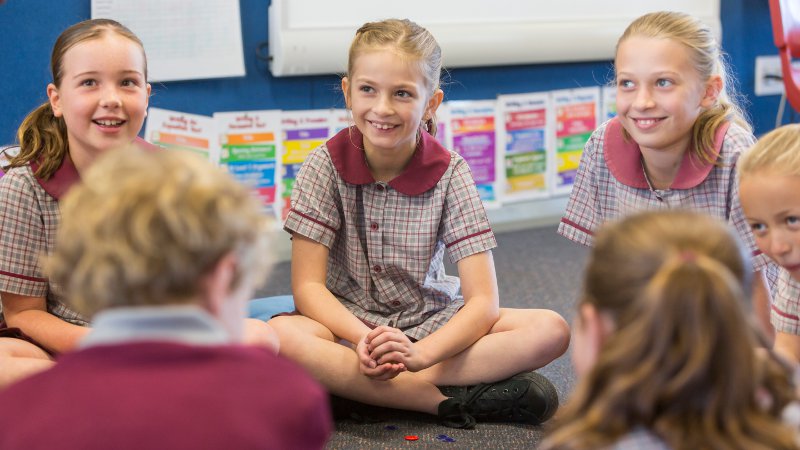
Strategies for pair and group work
What teachers and teacher aides should have been taught but probably were not.
Pair and group work – students work in pairs or small groups (of 3-5) to complete a task or activity.

Pair and group activities take up the lion’s share of time in many lessons. They have been a favourite of teachers for many decades and there is no doubt that will continue to be true in the future. Pair work is when 2 students are instructed to partner up in order to complete a task set by the teacher. Tasks can be as short as 30 seconds to as long as hundreds of hours (such as with extended investigations). If students are seated in pairs, the teacher will instruct them to ‘work with their partner’. If they have another seating arrangement, the teacher will either allow students to choose a partner or they will quickly organise pairs by pointing at each student and saying something along the lines of ‘you 2 work together; and you 2; and you 2; and you and you; and Josh and Sabrina; thank-you’.
Tasks can be as short as 30 seconds to as long as hundreds of hours (such as with extended investigations).
Group activities are no different than pair activities in many ways, except for the number of students. A group is 3 or more students but not the whole class (as that would be a whole-of-class activity). Optimal group size has long been the source of debate, however 3-4 is rarely a problem.i Groups of 6 or more can become unwieldy and shy students may withdraw from participating.
There are no concrete rules about how often pair or group work should be implemented. The primary driver behind the decision to use any strategy is how it contributes to achieving the educational goals of the program. Some teachers give little time to tasks of this nature and prefer teacher-centred strategies and individual work. Art classes are an example of this: students watch the teacher model a skill using a think-aloud and then work on their individual project. Other teachers allocate a significant portion of the lesson or program to student-centred activities such as pair and group work. Most teachers are somewhere in between and use a combination of teacher-centred (whole-of-class), individual work and pair and group work.
Groups of 6 or more can become unwieldy and shy students may withdraw from participating.
A typical 60-minute class in many schools might looks something like this:
- teacher-centred modelling/presentation including questioning and feedback (15 minutes)
- individual work (practise) with the teacher circling and providing support (10 minutes)
- pair work extending on individual work, such as checking each other’s answers (5 minutes)
- whole-of-class discussion, questions and responses from pair work (5 minutes)
- group activities such as jigsaws, mind maps, discussions or challenges (10 minutes)
- feedback from groups to the whole class or a challenge activity (10 minutes)
- teacher-centred consolidation, revision and summary (5 minutes).
Not all classes look like the above. While it is typical, it is only one potential structure from a multitude of options. Some classes are simpler in terms of structure and may be up to 100% teacher-centred (such as a lecture) or entirely student-centred (such as a computer lab or online research). Sports activities are naturally pair- and group-based. Music and art classes (other than performing arts) lean toward individual learning but in a collegial environment. Language, literacy and numeracy lessons commonly use a combination of strategies. The exact combination of individual, pair and group work depends on 4 key factors:
- the teacher’s beliefs about what ‘good’ teaching looks like
- the teacher’s philosophies about the purpose of education (core skills vs. social skills)
- the nature of the subject/topic and the time available
- the nature of the student cohort (including any behavioural issues).
Group work opens a Pandora’s box of potential issues and it can expose more serious underlying issues such as bullying.
One of the biggest factors (particularly in upper primary and middle school) is the extent of behavioural issues in the class. In addition, some classes are simply ‘louder’ than others because they contain more extroverts, Type As or attention-seekers. Student groups that ‘click’ tend to be louder overall as students are more willing to participate and engage in dialogue. Group work opens a Pandora’s box of potential issues and it can expose more serious underlying issues such as bullying. It also has the potential to exaggerate any existing or potential behavioural issues due to the fact that group activities are by nature less controllable than individual silent work. Boisterous classes can be concerning even for the most competent teachers. Customary practice is to begin the year with teacher-centred activities and to gradually introduce student-centred activities over time as students learn what the teacher expects.
Hint: beginning teachers often fall into the trap of implementing pair and group work as often as possible to reduce the anxiety and stress of teaching and managing 30-odd students at once. However, as they gain experience and confidence, teachers soon learn that teacher-centred activities (even with more challenging classes) are usually easier to manage than student-centred activities (or at least they are on par).
Following the decision to have students work with their peers, other decisions needs to be made. Firstly, is the activity suited to pair or group work, and for groups, what is the ideal size? Some activities (such as brainstorming) work better with larger groups. Other activities like reading may suit smaller groups or pairs. Group sizes are also partly determined by the number of students in the class. A class of 30 can easily be divided into 6 groups of 5 students. A class of 12 is more likely to be divided into pairs or groups of 3.
A final consideration is whether to move students around the room. For pairs no movement is necessary, however some students will need to move in order to form larger groups. If groups are formed with students already sitting near each other, there is little reason for them to move too far. However, if groups are formed in any other way, students may need to move to designated areas. This can lead to behavioural issues as students travel from their seat to the group location (this point in the lesson is known as a ‘transition’ and needs due attention as it is the point where the teacher pays the least amount of attention but students are the most excited).
Teachers need to think about the best way to allocate students to each pair or group. This is a key element in ensuring that the proceeding activity runs smoothly. Convenience often dictates that students work with their closest neighbours, although this is not always desirable. Groups can be allocated in a number of ways, such as allowing students to form their own groups, allocating students randomly with colour cards or numbers, or simply pointing at students to form groups based on different personalities and abilities. A common technique used with adults is to ask students to pair with someone who they have not worked with before.
Teachers need to think about the best way to allocate students to each pair or group. This is a key element in ensuring that the proceeding activity runs smoothly.
Thought should be given to students who prefer to work on their own. These students are not necessarily anti-social but take a ‘get the job done – no mucking around’ approach. They tend to be higher-performing students capable of directing their own learning and they see no point in ‘learning’ from (or with) non-experts. To them, pair and group activities are a waste of time – they would rather learn from experts such as the teacher or practise on their own. For many students however, pair and group activities provide an opportunity to interact with their peers and they welcome the break from listening to the teacher or working silently. Pair and group activities are also notably effective for revision and consolidation activities.
Hint: research has shown that when students are given the choice of working individually or in groups, they often choose to work individually.ii One of the reasons for this is a belief that they can do a better job than the group. Social anxiety and loss of control may also play a role.
You may have heard terms such as ‘cooperative learning’ and ‘collaborative learning’ (particularly from researchers, teacher trainers and curriculum developers) when referring to pair or group work. However, teachers usually speak of ‘pair work’ or ‘working in pairs’ and ‘group work’ or ‘working in groups’. The terms ‘collaborative learning’ and ‘cooperative learning’ are often used interchangeably although there are some differences. Cooperative learning is where students work together to achieve a pair or group outcome such as solving a maths problem. Almost all pair and group work in schools is cooperative learning. The teacher plans and coordinates short activities that target specific core skills. Think-pair-share, learning by teaching, peer tutoring and jigsaws are all pair or group-work examples of cooperative learning.
While cooperative learning is concerned with a shared end goal, collaborative learners on the other hand may have separate goals. However, they temporarily collaborate for their mutual benefit – ‘quid pro quo’ style. Collaborative learning is more appropriate for older students and longer projects such as investigations. It is student-centred by nature, although the degree of teacher involvement can vary. More confusing again is the fact that many activities are a hybrid of cooperative and collaborative learning. For example, students who collaborate as part of their individual projects often engage in short-term cooperative learning activities that have a mutually beneficial goal.
Technical definitions aside, the key takeout is to use best-practice teaching strategies and techniques for all pair and group-work activities and to use this strategy like any other: strategically, methodically and systematically to achieve the learning goals of the lesson. It should not be overused or employed ‘because that is what teachers do’ – it should be employed ONLY when it is the MOST effective means by which the learning goals can be achieved (like all strategies).
Foot notes:
- Optimal group size is largely a teacher decision, but a rule of thumb has always been that 4-5 is workable from the perspective of behaviour and learning. As groups become larger, more students withdraw from taking part and a smaller number of students dominate the activity.
- See for example: Chang, Y., & Brickman, P. (2018). When Group Work Doesn't Work: Insights from Students. CBE life sciences education, 17(3). doi:10.1187/cbe.17-09-0199.











